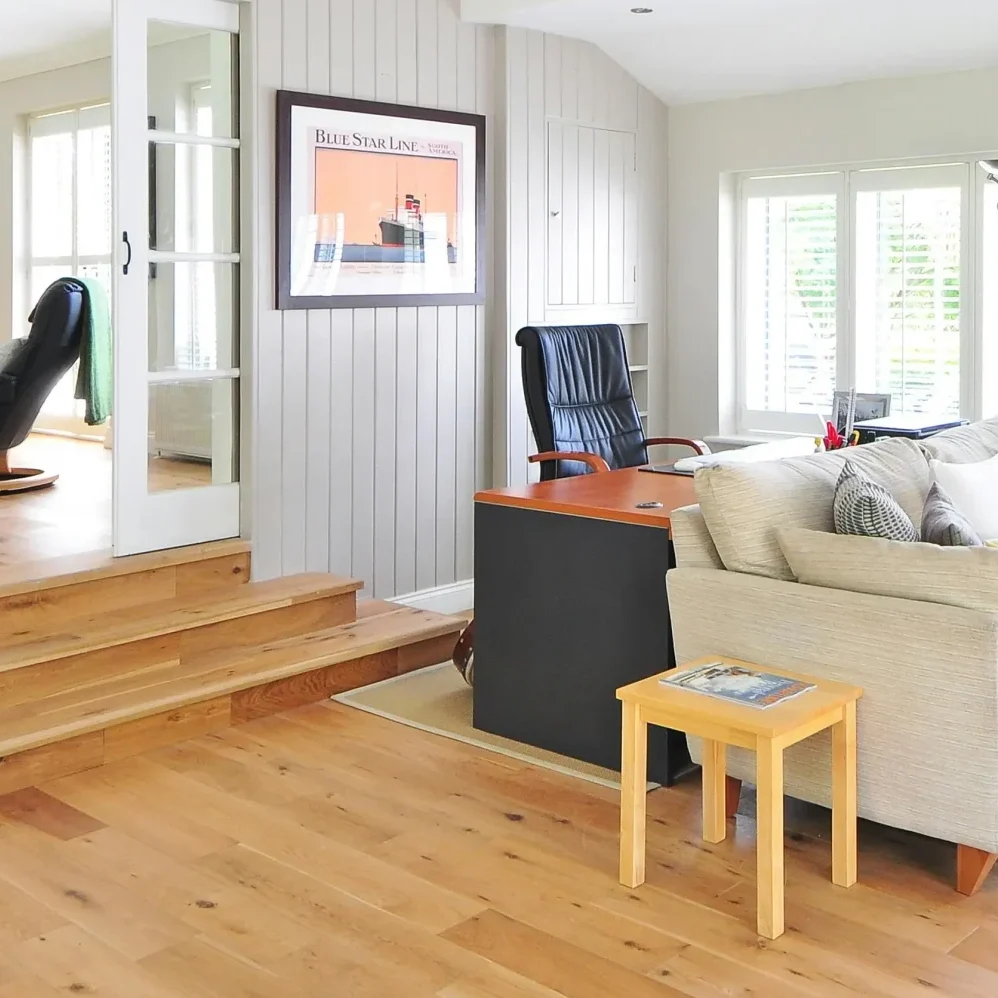- October 14, 2024
To remove water stains from wood floors, apply mayonnaise or a baking soda paste and water, and gently rub the stain before wiping it clean. Use the iron method for deeper stains by placing a cloth over the stain and applying a low-heat iron for a few seconds, or consider sanding and refinishing the area if necessary.
Homeowners love wood floors. They add warmth and elegance to your living space. But still, they are not immune to everyday challenges, particularly water stains, which can detract from their natural beauty.
These unsightly marks often result from spills, humidity, or simply the wear and tear of daily life. Understanding how these stains form and how to remove them effectively is essential for maintaining the allure of your wood floors. We will explore ten practical methods for tackling water stains, empowering you to restore your floors and keep them looking their best. Whether you are dealing with light spots or more stubborn marks, there is a solution that can help you reclaim the beauty of your hardwood.
Understanding Water Stains on Wood Floors
Water stains on wood floors are common and can be frustrating for homeowners. These stains often manifest as white or cloudy spots, detracting from the beauty of your flooring. Understanding how these stains form can help you take preventative measures and address them effectively.
How Water Stains Form
- Moisture Exposure: Water stains typically occur when moisture comes into contact with the wood surface. It happens from spills, wet shoes, or humidity in the air. When water penetrates the finish of the wood, it can disrupt the surface, leading to discoloration.
- Finish Breakdown: The protective finish on wood floors, usually made of polyurethane, varnish, or lacquer, is designed to repel moisture. However, wear and tear can weaken this barrier, making it less effective. When the finish is compromised, water can seep into the wood, causing stains.
- Temperature Changes: Rapid changes in temperature and humidity can also contribute to water stains. Wood is a natural material that expands and contracts with moisture changes. When wood absorbs water, it may swell and cause the finish to lift, leading to cloudiness.
- Inadequate Maintenance: Neglecting regular cleaning and maintenance can exacerbate the problem. Dirt, grime, and residual moisture can build up, making it easier for stains to form. Using harsh chemicals can strip the finish, leaving the wood vulnerable.
Common Sources of Water Stains
- Spills: Water, juice, or other liquids can soak into the wood.
- Pets: Water bowls or accidents can lead to staining.
- Humidity: High humidity causes moisture buildup, especially in poorly ventilated areas.
- Condensation: Water can accumulate from air conditioning units or heating vents, creating damp spots.
Prevention Tips
Preventing water stains on wood floors is essential to maintain their beauty and longevity. Here are some tips to help you keep your wood floors looking pristine:
1. Promptly Clean Spills
Wipe up any spills or moisture immediately using a soft cloth or paper towel to prevent water from seeping into the wood.
2. Use Area Rugs and Mats
Place area rugs in high-traffic areas and near entrances to catch moisture and dirt before they reach your floors. Ensure rugs are breathable to avoid trapping moisture.
3. Maintain Humidity Levels
Keep indoor humidity levels 30-50%. Use a dehumidifier or air conditioner to prevent excessive moisture in the air.
4. Seal Your Floors
Apply a high-quality wood floor sealant to create a protective barrier against moisture. Follow the manufacturer’s recommendations for maintenance.
5. Avoid Excessive Water Use
When cleaning, use a damp mop rather than soaking the floor. Too much water can penetrate the seams and cause damage.
6. Implement a No-Shoes Policy
Encourage a no-shoes policy in your home to minimize dirt and moisture being tracked in from outside.
7. Inspect Plumbing Regularly
Regularly check for leaks or plumbing issues in areas near your wood floors, such as kitchens and bathrooms, to address potential water sources early.
8. Use Furniture Coasters
Place coasters or protective pads under furniture legs to prevent moisture transfer from wood furniture to your floors.
9. Avoid Direct Sunlight
Use curtains or blinds to protect floors from direct sunlight, which can cause finishes to fade and become more susceptible to stains.
10. Regular Maintenance
Keep your wood floors clean and well-maintained by sweeping or vacuuming regularly and applying appropriate cleaners.
By following these prevention tips, you can help safeguard your wood floors against water stains and keep them looking beautiful for years to come.
Also Read: Have a pet? Explore the best pet-friendly floors.
10 Easy Ways of How to Remove Water Stains from Wood Floor
1. Iron Method
Using an iron can help lift the stain.
- How to Do It: Place a clean, dry cloth over the stain and set an iron to a low setting. Gently press the iron on the cloth for about 10 seconds, then lift it to check the stain.
- Tip: Always keep the iron moving slightly to avoid scorching the wood. Repeat as necessary, but avoid overheating the wood, as this can cause further damage.
2. Mayonnaise
Mayonnaise contains oils that can penetrate the wood and help remove the stain.
- How to Do It: Apply a small amount directly onto the stain, let it sit for a few hours or overnight, then wipe away with a clean cloth.
- Tip: For stubborn stains, you can add a little vinegar to the mayonnaise to enhance its effectiveness.
3. Baking Soda Paste
Baking soda is a gentle abrasive that can help lift stains.
- How to Do It: Mix equal parts baking soda and water to form a paste. Apply it to the stain, gently rubbing it in a circular motion. Wipe it off with a damp cloth and dry the area thoroughly.
- Tip: Ensure the area is completely dry after cleaning, as excess moisture can lead to new stains.
4. Vinegar and Olive Oil
This natural mixture cleans while nourishing the wood.
- How to Do It: Combine equal parts vinegar and olive oil. Apply to the stain, let it sit for about 30 minutes, and then wipe it off.
- Tip: Use this method regularly for maintenance, as it can help keep wood floors looking fresh.
5. Toothpaste
Toothpaste can serve as a mild abrasive for removing stains.
- How to Do It: Use a non-gel, non-whitening toothpaste. Apply a small amount to a soft cloth and gently rub the stain. Wipe with a damp cloth afterward to remove any residue.
- Tip: Be cautious with excessive scrubbing, as it may damage the finish if applied too aggressively.
6. Commercial Wood Floor Cleaner
Using a product designed for wood floors can provide optimal results.
- How to Do It: Follow the manufacturer’s instructions for best results. Test a small area first to ensure it doesn’t damage your finish.
- Tip: Look for products that specifically mention stain removal for best outcomes.
7. Lemon Juice and Olive Oil
This mixture not only cleans but also adds shine to the wood.
- How to Do It: Mix one part of lemon juice with two parts of olive oil. Apply to the stain and let it sit for a while before wiping it off.
- Tip: This method also helps combat odors and keeps the wood smelling fresh.
8. Sand and Refinish
For deep stains that don’t respond to other methods, sanding and finishing may be necessary.
- How to Do It: Lightly sand the area with a fine-grit sandpaper. Be careful not to damage surrounding areas. After sanding, apply a matching wood finish to blend the area.
- Tip: Always sand in the direction of the wood grain to avoid scratches.
9. Heat and Moisture
Applying controlled heat can help lift the stain.
- How to Do It: Place a damp cloth over the stain and use a hairdryer on low heat to apply warmth. The moisture can help lift the stain.
- Tip: Check frequently to avoid damaging the wood. Do not use excessive heat, as it can warp the wood.
10. Call a Professional
If the stains persist despite your best efforts, consider consulting a professional.
- How to Do It: A professional cleaner will have specialized tools and products designed for tougher stains.
- Tip: Regular maintenance and immediate attention to spills can help prevent stains in the future.
Key Points
- Understanding Water Stains: Water stains occur when moisture seeps into the wood finish, often from spills, humidity, or wear over time.
- Common Sources: Spills, pet water bowls, condensation, and high humidity levels can lead to water stains.
- Effective Removal Methods:
- Iron Method: Use a cloth and low-heat iron to lift the stain.
- Mayonnaise: Apply and let it sit for several hours.
- Baking Soda Paste: Create a paste and gently rub it on the stain.
- Vinegar and Olive Oil: Mix and apply to nourish and clean the wood.
- Toothpaste: Gently rub with non-gel toothpaste before wiping clean.
- Prevention Tips: Promptly clean spills, use area rugs, maintain stable humidity, and perform regular maintenance.
Conclusion
Water stains on wood floors can be frustrating, but understanding how to effectively remove them can help restore your flooring to its original beauty. By employing methods such as the iron technique, using mayonnaise, or creating a baking soda paste, you can tackle light stains with relative ease. For more persistent marks, options like sanding and refinishing or seeking professional help are available to ensure your floors are thoroughly cleaned without damaging the wood.
Regular maintenance and prompt attention to spills are key to preventing future stains. Remember that using appropriate cleaning methods and products can greatly enhance the longevity of your wood floors. For those looking to upgrade or install new wood flooring, Elephant Floors offers a range of high-quality options tailored to your needs. Visit us today to discover the perfect flooring solution that combines beauty, durability, and expert support. Your stunning floors are just a step away!




